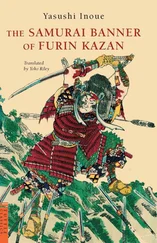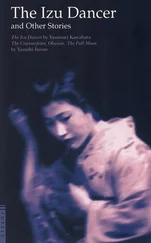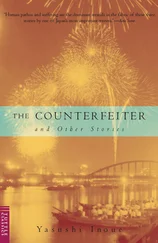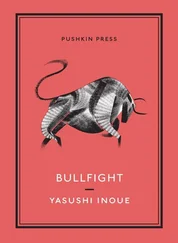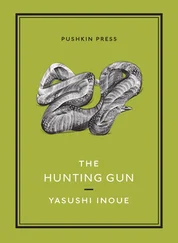Partway down a long, winding hall my friend and I were offered straw sandals to wear and taken out to see the spacious garden; after that, we were shown to the large room on the second floor where the patriots had had their gatherings.
According to the explanation we were given by a middle-aged woman who could have been either the proprietress or the head serving woman, Takasugi Shinsaku, Sakamoto Ryōma and various others had come here to enjoy themselves, to plot against the shogunate, and to plan their “Naval Auxiliary Force.” Gesturing at a spot on the pillar in the alcove, she informed us that we could see gashes there that Sakamoto Ryōma had left during a sword dance. It was true: the old pillar, made from mulberry or some similar wood, bore two scars that looked to have been made by a sword.
A scroll by Rai San’yō hung in the alcove. And just to the side of the alcove, leaning outward from the transom, was a horizontal frame holding a work of calligraphy large enough to suit the spacious room. I gazed up at the piece, assuming it must have been done by another of the patriots, only to find that the four thick characters, which read “Compose on the flowers, sing of the moon,” had been signed “Ranchū,” and that in the square stamp under the signature I could clearly make out the name Matsumoto Jun.
That a sample of calligraphy by Ranchū, aka Matsumoto Jun, should be hanging in such a place was entirely unexpected, and it evoked a certain nostalgia in me, as though I had bumped into an old friend I had not seen in ages in some spot where I would never have thought to run into him.
Matsumoto Jun was a doctor who was active from the final decade of shogunal rule into the Meiji era, and while he was not as widely known as the old patriots, as they are called, one could not possibly tell the history of medicine in Japan without referencing his name. As it happens, my great-grandfather was one of his pupils, and the relationship between them went deeper than that of mere master and disciple; as a result, I was used to hearing his name from the time I was small.
I asked the woman who was taking us around about Matsumoto Jun, but she knew nothing at all about him. She went down to the reception area to ask how his calligraphy had come to be hanging in the room, but in the end all she could tell us was that the owners said it had been there for as long as they knew, and they had left it up because there was no particular reason to take it down; beyond that, the most they could offer was that the calligrapher had been a doctor.
Though at first the writing had felt out of place, upon reflection I realized it wasn’t really all that surprising that Matsumoto Jun should have come here to enjoy himself.
Looking him up in a biographical dictionary, this is what one finds:
Matsumoto Jun; childhood name Ryōjun; pen name Ranchū. Second son of Sakura domain physician Satō Taizen. Born on the 16th of the 6th month of Tenpō 3. In Kaei 3, having been adopted as successor by shogunal physician Matsumoto Ryōsuke, he was dispatched by the shogunate to study in Nagasaki; upon returning to Edo he opened his own school and took pupils. In Meiji 1, during the Boshin War, he was imprisoned after establishing a hospital in Aizu to tend to the Northeast Army troops; subsequently pardoned, he went on to found a hospital in Waseda, then through Lord Yamagata obtained a post in the Ministry of War, where he worked tirelessly to set up the Army Medical Division and the Army Hospital in Hanzōmon. During the Saga Rebellion, the Conquest of Taiwan, the Seinan War, and other conflicts, he presided over medical affairs from Tokyo, serving as the country’s first surgeon general. The convention by which families of fallen soldiers make pledgets with their own hands to send to the front is said to originate in a proposal he made to the government. In Meiji 23, Matsumoto joined the House of Peers; in Meiji 28, he became a baron. He died on March 23, Meiji 40, at the age of 76.
One can see even from this résumé of his career that as a young man he had deep ties to Nagasaki, and given the evidence, his appearance at this restaurant was probably nothing to wonder at.
*
The person who planted in my childish heart, when I was still very small, an image of Matsumoto Jun as a man more worthy of respect than anyone else in the world was the woman my great-grandfather had taken as his mistress.
From the age of six until the spring of my thirteenth year, when I was in fifth grade, I was raised by this woman, then in her mid-fifties, at our ancestral home on the Izu peninsula. I only went to live with my family, joining my parents in the city, after Grandma Kano — this was what we called her — passed away. The reason I was raised by Grandma Kano, startling as it might seem, was that after my great-grandfather and his wife Suga died, when Grandma Kano’s distinctive position as a mistress no longer really mattered, she had begun living as a member of our family on funds my parents sent her; even then, however, she could never entirely shed the wariness she felt on account of the odd status she had occupied all her life, ever since she was a young woman, and so, even though two generations had passed since my great-grandfather headed the family, she thought it would be best to strengthen her position by keeping me with her as the eldest son and heir.
My parents were young then, and in the face of Grandma Kano’s persistent requests they appear to have decided, in a rather offhand way, that it would make things easier anyway if she was willing to take me, and left me in her charge. In short, I was Grandma Kano’s hostage.
Even as a boy, I could tell that Grandma Kano was beautiful. There was a certain severity to her features, but it was clear her looks must have been remarkable when she was young. She came from a port town on the other side of Mt. Amagi, just across from my hometown, but at the age of eighteen or nineteen she had gone up to Tokyo as a geisha and become acquainted almost immediately with my great-grandfather, Kiyoshi, who soon redeemed her; from then on, he kept her with him wherever he was employed: during his stint as family doctor to the great Egawa clan, and as the first director of the Shizuoka Prefectural Hospital system, as he moved from one city to the next, including Kakegawa, Mishima and Shizuoka. When at the age of forty poor health obliged Kiyoshi to return home and set up a practice there, she showed herself for the first time in his hometown, half openly, taking her place as my great-grandfather’s second wife. She was twenty-six at the time.
From then until her death at age sixty-three, for more than three decades, she struggled constantly against the chilly reception she was given in a rural area where every aspect of life was dominated by a feudalistic morality, even when no one’s mistress was involved. Clearly, then, she had a strong will. She tended conscientiously to the needs of my great-grandfather’s principal wife Suga, and served all our other relatives well. Still, she appears to have acquired a reputation as a forceful, clever woman who, precisely because she was so forceful and clever, had to be carefully watched, because one could never tell what she might be plotting.
Of all the things Grandma Kano told me between my sixth and thirteenth year, during which time she and I lived on the second floor of our family’s small storehouse, the main building having been rented to an official in the Forestry Bureau, only two have remained with me to the present: that my grandfather, very generous with his money, ran through cash like water; and that Matsumoto Jun was the most magnificent person, and a truly worthy man. Grandma Kano called Matsumoto Jun “Sensei.” He was the only person she referred to in that way. She never once applied the term to the principal of my elementary school, not even when she addressed him. She seemed to feel that to use the same term in reference to anyone else would constitute an affront to Matsumoto Jun’s dignity.
Читать дальше


